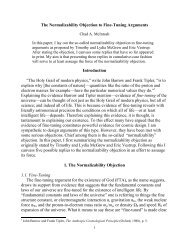Theism and Explanation - Appeared-to-Blogly
Theism and Explanation - Appeared-to-Blogly
Theism and Explanation - Appeared-to-Blogly
Create successful ePaper yourself
Turn your PDF publications into a flip-book with our unique Google optimized e-Paper software.
Potential Theistic <strong>Explanation</strong>s 83<br />
be constrained by laws. And, as Sober suggests, appeal <strong>to</strong> analogies will<br />
not take us very far, since the divine agent is so unlike any other agent with<br />
which we are familiar. But a proposed theistic explanation is constrained<br />
by the presumption of rationality upon which all intentional explanations<br />
rely (3.2.1; Appendix 1.3). It assumes that God will act in a way that is consistent<br />
with his beliefs <strong>and</strong> desires <strong>and</strong> that he will act in a way that would<br />
bring about his goal. Just what this means, in the case of a divine agent, is<br />
a question <strong>to</strong> which I shall return in a moment (5.3).<br />
5.2.2 The P<strong>and</strong>a’s Thumb<br />
Sober’s neglect of this rationality principle is evident in his criticism of<br />
Stephen Jay Gould’s essay on “the p<strong>and</strong>a’s thumb.” In that essay, Gould<br />
describes his childhood encounter with a p<strong>and</strong>a at Washing<strong>to</strong>n Zoo. He<br />
was struck by the p<strong>and</strong>a’s ability <strong>to</strong> strip the leaves off shoots of bamboo,<br />
apparently with the aid of a fl exible thumb. “This puzzled me,” he<br />
writes, “I had learned that a dexterous, opposable thumb s<strong>to</strong>od among<br />
the hallmarks of human success. We had maintained, even exaggerated,<br />
this important fl exibility of our primate forebears, while most mammals<br />
had sacrifi ced it in specializing their digits.” 18 Then, <strong>to</strong> his further amazement,<br />
he observed that the p<strong>and</strong>a has fi ve remaining digits. Had the p<strong>and</strong>a<br />
evolved a sixth fi nger? In due course, he discovered that it had not. The<br />
p<strong>and</strong>a’s “thumb” is, in fact, a cobbled <strong>to</strong>gether contraption, fashioned by<br />
variation <strong>and</strong> natural selection from bones <strong>and</strong> muscles that already existed<br />
in the wrist. It is, as Gould writes, “a somewhat clumsy, but quite workable”<br />
response <strong>to</strong> a need.<br />
Gould’s point is that arrangements such as this—there are plenty of them<br />
in the natural world—are strong evidence in support of Darwin’s theory of<br />
evolution. As Gould writes,<br />
our textbooks like <strong>to</strong> illustrate evolution with examples of optimal<br />
design—nearly perfect mimicry of a dead leaf by a butterfl y or of a<br />
poisonous species by a palatable relative. But ideal design is a lousy<br />
argument for evolution, for it mimics the postulated action of an omnipotent<br />
crea<strong>to</strong>r. Odd arrangements <strong>and</strong> funny solutions are the proof<br />
of evolution—paths that a sensible God would never tread but that a<br />
natural process, constrained by his<strong>to</strong>ry, follows perforce. No one unders<strong>to</strong>od<br />
this better than Darwin himself. 19<br />
I shall refer <strong>to</strong> this shortly as a “suboptimality argument” against proposed<br />
theistic explanations. What is of interest here is that Elliot Sober<br />
disagrees with this argument.<br />
Gould thinks he knows what God would do if He built p<strong>and</strong>as, just as<br />
Paley thought he knew what God would do if He built the vertebrate



